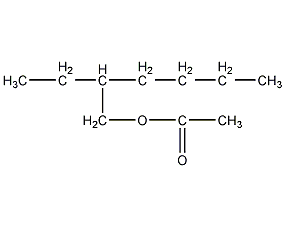
Structural formula
| Business number | 02MW |
|---|---|
| Molecular formula | C10H20O2 |
| Molecular weight | 172.27 |
| label |
2-ethylhexyl acetate, Acetic Acid 2-Ethylhexyl Ester, Octyl Acetate, spices, aliphatic compounds |
Numbering system
CAS number:103-09-3
MDL number:MFCD00027249
EINECS number:203-079-1
RTECS number:AH5600000
BRN number:1758321
PubChem number:24902074
Physical property data
1. Properties: colorless liquid with fruity aroma.
2. Relative density (g/mL, 20/20℃): 0.8734
3. Relative vapor density (g/mL, air=1): 6.0
4. Melting point (ºC): -93
5. Boiling point (ºC, normal pressure): 199
6. Relative density (20℃, 4℃): 0.8749
7. Refractive index (n20ºC): 1.4204
8. Flash point (ºC, opening): 87.8
9. Viscosity (mPa·s, 20ºC ): 1.5
10. Refractive index at room temperature (n25): 1.4182
11. Critical pressure (MPa): 2.09
12. Saturated vapor pressure (kPa, 20ºC): 0.053
13. Heat of evaporation (KJ/mol, 25ºC): 48.15
14. Critical temperature (ºC): 368.85
15. Thermal conductivity (W/(m·K), 10~30ºC): 0.4145
16. Specific heat capacity (KJ/(kg·K), constant pressure): 2.09
17. Critical density (g·cm-3): 0.253
18. Critical volume (cm3·mol -1): 681
19. Solubility: Miscible with organic solvents such as alcohols, ethers, and hydrocarbons, 0.03% dissolved in water at 20°C; water in acetic acid- Dissolve 0.55% in 2-ethylhexyl ester.
20. Critical compression factor: 0.267
21. Eccentricity factor: 0.631
22. Liquid phase standard hot melt (J·mol-1 ·K-1): 348.8
Toxicological data
1. Skin/eye irritation: Start irritation test: Rabbit skin contact, 10mg/24H; Start irritation test: Rabbit skin contact, 500mgREACTION SEVERITY, slight reaction; Standard Dresser test: Rabbit eye contact, 500mgREACTION SEVERITY, slight reaction; Standard Dresser Test: Rabbit Eye Contact, 500mgREACTION SEVERITY, mild reaction; 2. Acute toxicity: Rat oral LD50: 3mg/kg; Rat inhalation LC: >1100ppm/6H; Mouse oral LD50: >3200mg/kg; Rabbit skin contact LD: >20mL/kg ; Guinea pig skin contact LD50: >20mL/kg; 3. Low toxicity and can be absorbed through the mouth and respiratory tract. Under normal conditions of use, it will not cause significant physiological damage. Rats exposed to the concentrated vapor of 2-ethylhexyl acetate for 15 minutes will not die.
Ecological data
This substance is slightly hazardous to water.
Molecular structure data
1. Molar refractive index: 50.11
2. Molar volume (cm3/mol): 197.4
3. Isotonic specific volume (90.2K ): 452.1
4. Surface tension (dyne/cm): 27.4
5. Dielectric constant:
6. Dipole moment (10-24cm3):
7. Polarizability: 19.86
Compute chemical data
1. Reference value for hydrophobic parameter calculation (XlogP): 3.2
2. Number of hydrogen bond donors: 0
3. Number of hydrogen bond acceptors: 2
4. Number of rotatable chemical bonds: 7
5. Number of tautomers: none
6. Topological molecule polar surface area 26.3
7. Number of heavy atoms: 12
8. Surface charge: 0
9. Complexity: 121
10. Number of isotope atoms: 0
11. Determine the number of atomic stereocenters: 0
12. Uncertain number of atomic stereocenters: 1
13. Determine the number of chemical bond stereocenters: 0
14. Number of uncertain chemical bond stereocenters: 0
15. Number of covalent bond units: 1
Properties and stability
Avoid contact with strong oxidants, strong acids, and strong alkalis. It is non-corrosive to metals when dry. Copper containers should not be used because trace amounts of acetic acid generated by hydrolysis are corrosive to copper. It has the general chemical properties of esters and is easily hydrolyzed in the presence of caustic alkali.
Storage method
Store in a cool, ventilated warehouse. Keep away from fire and heat sources. They should be stored separately from oxidants, acids, and alkalis, and avoid mixed storage. Equipped with the appropriate variety and quantity of fire equipment. The storage area should be equipped with emergency release equipment and suitable containment materials.
Synthesis method
Refining method: Contains impurities such as free acid and alcohol. During refining, wash with sodium bicarbonate or sodium carbonate aqueous solution, dry with anhydrous sodium carbonate or sodium sulfate and then rectify.
Purpose
Used as a solvent for brushing, nitrocellulose spray paint, baking paint, latex paint, etc. Also used in spice manufacturing.



 微信扫一扫打赏
微信扫一扫打赏
